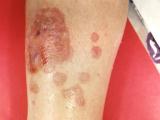Apr 9, 2002 (CIDRAP News) – An analysis by the Centers for Disease Control and Prevention (CDC) suggests that a multidrug-resistant strain of Salmonella enterica that emerged as a common human pathogen in the United States in the mid-1990s was present in the country as early as 1985.
The report in the April issue of Emerging Infectious Diseases deals with multidrug-resistant S enterica serotype Typhimurium definitive type 104, or MR-DT104, described as one of the most common Salmonella strains found in humans. The authors compared the integron content, plasmid profiles, and pulsed-field gel electrophoresis (PFGE) patterns of MR-DT104 specimens isolated from humans in 1985, 1990, and 1995 and found them nearly indistinguishable.
"The data suggest that the widespread emergence of MR-DT104 in humans and animals in the 1990s may have been due to the dissemination of a strain already present in the United States rather than the introduction of a new strain," says the report by Efrain M. Ribot and colleagues.
MR-DT104 was first isolated from humans in 1984 in the United Kingdom, but it did not become common in the United States until the mid-1990s, the authors report. Among Salmonella isolates sent by state laboratories to the CDC in 1995, 28% of 975 S enterica Typhimurium isolates had the resistance pattern commonly associated with MR-DT104. This compared with 7% of S Typhimurium isolates in 1990 and 5% in 1985. "Since Typhimurium was the most common serotype of Salmonella in the United States in 1999, causing 25% of the culture-confirmed infections . . . , MR-DT104 caused an estimated 7% of Salmonella infections," the article states. MR-DT104 is commonly resistant to ampicillin, chloramphenicol, streptomycin, sulfonamides, and tetracycline (MR-DT104 R type ACSSuT).
The investigators analyzed seven MR-DT104 strains isolated from sick people—one from 1985 and three each from 1990 and 1995. Local and state health departments and public health laboratories had sent the isolates to the CDC in those years in the course of surveys of antimicrobial resistance in Salmonella.
PFGE analysis, conducted with xbaI restriction enzyme, showed that the seven isolates were identical except for an extra band in one of the 1990 specimens—a "remarkable" level of clonality for specimens obtained up to 10 years apart. The plasmid profile analysis showed that all the isolates contained the 60-mDa plasmid that is commonly seen in MR-DT104.
Multidrug resistance is associated with the presence of two integrons, or genetic elements, found in the chromosomal DNA of MR-DT104 (R type ACSSuT) isolates, the authors report. To determine if these integrons were present in the 1985 and 1990 isolates, the authors conducted polymerase chain reaction amplification of chromosomal DNA and purified plasmid preparations. The analysis indicated that all isolates had four genes that conferred resistance to, respectively, streptomycin and spectinomycin, ampicillin, sulfonamides, and chloramphenicol.
The authors conclude that MR-DT104 organisms found in the United States as early as 1985 had PFGE patterns and integrons identical or nearly identical to those found in more recent isolates. "These data and the fact that food-producing animals are the reservoirs for most human Salmonella infections in the United States suggest that the emergence of MR-DT104 during the mid-1990s probably resulted from the dissemination of MR-DT104 in food-producing animal reservoirs," they state. However, they add, it is not known if this spread originated with domestic strains or through reintroduction of the strain through imported livestock or other carriers.
Ribot EM, Wierzba RK, Angulo FJ, et al. Salmonella enterica serotype Typhimurium DT104 isolated from humans, United States, 1985, 1990, and 1995. Emerg Infect Dis 2002;8(4)
Full text





















